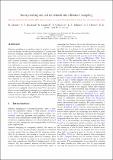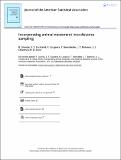Files in this item
Incorporating animal movement into distance sampling
Item metadata
| dc.contributor.author | Glennie, Richard | |
| dc.contributor.author | Buckland, Stephen Terrence | |
| dc.contributor.author | Langrock, Roland | |
| dc.contributor.author | Gerrodette, Tim | |
| dc.contributor.author | Ballance, Lisa | |
| dc.contributor.author | Chivers, Susan | |
| dc.contributor.author | Scott, Michael | |
| dc.date.accessioned | 2017-09-29T10:32:46Z | |
| dc.date.available | 2017-09-29T10:32:46Z | |
| dc.date.issued | 2020-06-08 | |
| dc.identifier | 251041173 | |
| dc.identifier | a90fbe19-9087-4e78-ace9-4256ff1131e5 | |
| dc.identifier | 85087021625 | |
| dc.identifier | 000543136200001 | |
| dc.identifier.citation | Glennie , R , Buckland , S T , Langrock , R , Gerrodette , T , Ballance , L , Chivers , S & Scott , M 2020 , ' Incorporating animal movement into distance sampling ' , Journal of the American Statistical Association , vol. Latest Articles , pp. 1-9 . https://doi.org/10.1080/01621459.2020.1764362 | en |
| dc.identifier.issn | 0162-1459 | |
| dc.identifier.other | ORCID: /0000-0002-9939-709X/work/78204874 | |
| dc.identifier.other | ORCID: /0000-0003-3806-4280/work/78205054 | |
| dc.identifier.uri | https://hdl.handle.net/10023/11757 | |
| dc.description | R. Glennie gratefully acknowledges the Carnegie Trust for funding his work on this research project. | en |
| dc.description.abstract | Distance sampling is a popular statistical method to estimate the density of wild animal populations. Conventional distance sampling represents animals as fixed points in space that are detected with an unknown probability that depends on the distance between the observer and the animal. Animal movement can cause substantial bias in density estimation. Methods to correct for responsive animal movement exist, but none account for nonresponsive movement independent of the observer. Here, an explicit animal movement model is incorporated into distance sampling, combining distance sampling survey data with animal telemetry data. Detection probability depends on the entire unobserved path the animal travels. The intractable integration over all possible animal paths is approximated by a hidden Markov model. A simulation study shows the method to be negligibly biased (<5%) in scenarios where conventional distance sampling overestimates abundance by up to 100%. The method is applied to line transect surveys (1999–2006) of spotted dolphins (Stenella attenuata) in the eastern tropical Pacific where abundance is shown to be positively biased by 21% on average, which can have substantial impact on the population dynamics estimated from these abundance estimates and on the choice of statistical methodology applied to future surveys | |
| dc.format.extent | 9 | |
| dc.format.extent | 324458 | |
| dc.format.extent | 954937 | |
| dc.language.iso | eng | |
| dc.relation.ispartof | Journal of the American Statistical Association | en |
| dc.subject | Abundance | en |
| dc.subject | Continuous-time | en |
| dc.subject | Diffusion | en |
| dc.subject | Hidden Markov model | en |
| dc.subject | QA Mathematics | en |
| dc.subject | QH301 Biology | en |
| dc.subject | I | en |
| dc.subject | BDC | en |
| dc.subject | R2C | en |
| dc.subject.lcc | QA | en |
| dc.subject.lcc | QH301 | en |
| dc.title | Incorporating animal movement into distance sampling | en |
| dc.type | Journal article | en |
| dc.contributor.institution | University of St Andrews. School of Mathematics and Statistics | en |
| dc.contributor.institution | University of St Andrews. Marine Alliance for Science & Technology Scotland | en |
| dc.contributor.institution | University of St Andrews. Scottish Oceans Institute | en |
| dc.contributor.institution | University of St Andrews. St Andrews Sustainability Institute | en |
| dc.contributor.institution | University of St Andrews. Centre for Research into Ecological & Environmental Modelling | en |
| dc.identifier.doi | 10.1080/01621459.2020.1764362 | |
| dc.description.status | Peer reviewed | en |
| dc.date.embargoedUntil | 2021-06-08 |
This item appears in the following Collection(s)
Items in the St Andrews Research Repository are protected by copyright, with all rights reserved, unless otherwise indicated.


